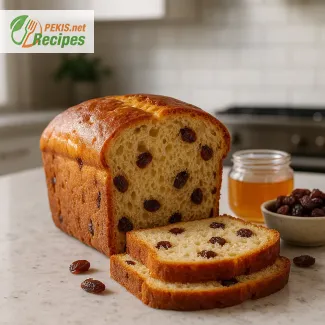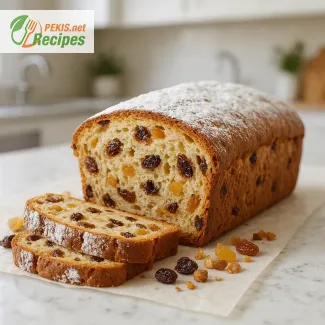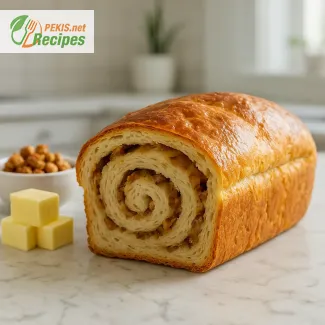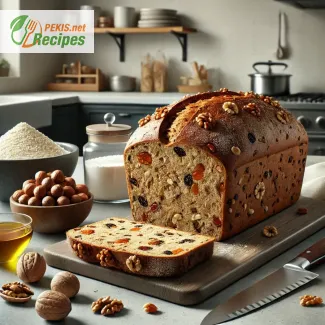
The secret to soft and fluffy white bread at home
Discover the timeless art of baking classic white bread from scratch
Baking traditional homemade white bread is a deeply rewarding experience that connects us to the rich heritage of home cooking. The aroma of freshly baked bread filling the kitchen evokes memories of comfort, warmth, and togetherness. This white bread recipe is celebrated for its simplicity, relying on basic ingredients that come together to create a loaf with a perfectly golden crust and a soft, airy crumb. For generations, homemade bread has been a staple on family tables, served warm with butter, transformed into hearty sandwiches, or enjoyed as a simple slice with jam.
The beauty of making white bread at home lies in the control you have over every step — from selecting high-quality flour to kneading the dough until it reaches that ideal elastic consistency. Each element of the process contributes to the final result: a loaf that is not only visually appealing but also rich in flavor and texture. Homemade white bread has a distinctive taste that sets it apart from store-bought versions, thanks to the freshness of ingredients and the care invested in its preparation.
What makes this white bread recipe unique?
The balance of ingredients for the perfect loaf
This traditional white bread recipe focuses on achieving the right harmony between flour, yeast, water, and fat. The choice of all-purpose flour or bread flour affects the structure and softness of the loaf, while the precise quantity of yeast ensures the dough rises beautifully without overpowering the subtle flavors. Water temperature plays a key role, as it activates the yeast and encourages even fermentation. The addition of butter or a neutral oil lends richness to the crumb, creating that irresistible softness we associate with the best white bread.
The importance of kneading and proofing
A defining step in creating homemade white bread is the kneading process. Kneading develops the gluten network that gives bread its structure and chew. Whether done by hand or using a stand mixer, proper kneading transforms the dough from a sticky mass into a smooth, elastic ball ready for its first rise. Proofing is just as crucial — allowing the dough to rest and rise in a warm environment enhances the texture, producing a light and airy loaf. A second proof before baking ensures an even crumb and an attractive domed top.
The role of baking techniques in achieving bakery-quality bread
How oven temperature and steam affect your loaf
Baking white bread is as much about technique as it is about ingredients. A well-preheated oven guarantees an initial burst of heat, crucial for oven spring — that rapid rise that gives the loaf its volume. Introducing steam during the first few minutes of baking helps create a thin, crisp crust while keeping the inside tender and moist. The balance between crust and crumb is what elevates traditional white bread from ordinary to exceptional.
Scoring and shaping for a beautiful finish
Scoring the top of your loaf isn’t just decorative — it guides the expansion of the bread as it bakes, preventing unwanted cracks and creating an artisanal appearance. Proper shaping ensures the loaf rises evenly and slices cleanly. Whether you prefer a classic sandwich loaf shape or a free-form round, attention to these final steps makes a difference in both appearance and texture.
Why homemade white bread is worth the effort
Superior flavor, freshness, and versatility
When you bake white bread at home, the rewards extend beyond the satisfaction of creating something from scratch. The flavor is unmatched — a subtle sweetness, a rich, buttery note, and a softness that lasts for days. Freshly baked bread is free from preservatives and unnecessary additives, offering a more wholesome choice for you and your family. Its versatility makes it perfect for everything from breakfast toast to gourmet sandwiches or even croutons for salads and soups.
Connecting with tradition through baking
There is something timeless about preparing traditional white bread. It is a skill passed down through generations, a ritual that brings people together. Baking bread offers a moment to slow down and appreciate the craft of creating food with your own hands. The process itself — from mixing to baking — is as satisfying as enjoying the first warm slice straight from the oven.
Common mistakes to avoid when making white bread
Using the wrong flour or improper measurements
One of the most frequent pitfalls in white bread baking is choosing the wrong type of flour or failing to measure ingredients accurately. Too little flour and the dough remains sticky and hard to handle; too much, and the loaf can become dense and dry. Using a kitchen scale for precision ensures consistency and quality in every bake.
Rushing the proofing process
Patience is key when making homemade bread. Cutting short the proofing time might save a few minutes but will compromise the bread’s lightness and flavor. Allowing the dough to rise fully ensures the development of those characteristic air pockets that make each bite soft and tender.
Overbaking or underbaking
Another common error is not baking the loaf for the correct duration. Underbaking results in a gummy crumb, while overbaking can dry out the bread and darken the crust excessively. Knowing your oven and checking the bread for doneness — by tapping the bottom for a hollow sound — ensures the perfect finish.
Enhancing your white bread with simple variations
Adding seeds, herbs, or sweet elements
Once you’ve mastered the basic white bread recipe, it’s easy to experiment with flavors and textures. Incorporate poppy seeds, sesame seeds, or sunflower seeds into the dough or sprinkle them on top before baking for added crunch and visual appeal. A touch of rosemary, thyme, or oregano can infuse your bread with a subtle herbal aroma, while a swirl of honey or molasses provides natural sweetness and a deeper color.
Trying different shapes and sizes
Don’t be afraid to shape your dough into rolls, braids, or baguette-style loaves. These variations not only change the appearance but also the crust-to-crumb ratio, allowing you to customize the texture to your preference. Small rolls bake faster and are ideal for individual servings, while larger loaves are perfect for sharing.
The joy of baking white bread at home
A rewarding experience for all skill levels
Whether you’re a beginner baker or have years of experience, making traditional white bread offers a fulfilling way to spend time in the kitchen. The process encourages mindfulness and creativity, with each loaf reflecting the care you put into it. As you refine your technique, you’ll discover the small adjustments that make a big difference — from the amount of kneading to the ideal rise time in your kitchen’s environment. The result is a loaf of homemade bread that looks, smells, and tastes incredible, bringing joy with every slice.
- In a small bowl, dissolve the active dry yeast and granulated sugar in the lukewarm water. Let it sit for about 10 minutes until foamy.
- In a large mixing bowl, combine the all-purpose flour and salt. Add the foamy yeast mixture and the butter.
- Mix the ingredients until a dough forms. Transfer the dough to a lightly floured surface and knead it for about 10 minutes until it becomes smooth and elastic.
- Place the dough in a lightly greased bowl, cover it with a clean kitchen towel, and let it rise in a warm place for about 90 minutes or until doubled in size.
- Punch down the risen dough and shape it into a loaf. Transfer it to a greased 9x5 inch (23x13 cm) loaf pan. Cover again and let it rise for another 30-45 minutes until the dough has risen just above the edge of the pan.
- Preheat your oven to 190°C (375°F). Bake the bread for 30 minutes or until golden brown and the loaf sounds hollow when tapped on the bottom.
- Remove the bread from the pan and let it cool on a wire rack before slicing.
Creative ways to enhance your homemade white bread
Explore ingredient variations and techniques for an elevated baking experience
When it comes to traditional homemade white bread, small adjustments and thoughtful ingredient choices can transform a familiar recipe into something extraordinary. The foundation of this bread — a delicate balance of flour, yeast, water, and butter — allows ample room for personalisation without compromising the classic character of the loaf. Enhancing this beloved recipe is about understanding how subtle changes affect texture, flavor, and nutritional value, offering you the chance to create a loaf that perfectly suits your taste and lifestyle.
Adding ingredients such as milk instead of water can make the crumb even softer and give the bread a slightly richer flavor. The natural sugars in milk contribute to a deeper golden crust and a subtly sweet note that pairs wonderfully with both savory and sweet toppings. Similarly, incorporating a tablespoon of honey or molasses not only lends a mild sweetness but also helps retain moisture, keeping the bread fresh for longer. For those seeking a more complex flavor profile, consider adding a spoonful of olive oil — it introduces a gentle richness while improving the crumb’s tenderness.
Healthier alternatives for modern tastes
Swapping all-purpose flour for whole wheat flour or a blend of whole grain and white flour increases the fiber content and adds a nutty, earthy note to the bread. While whole wheat dough may require slightly more liquid and longer kneading to achieve the desired elasticity, the result is a more wholesome loaf that aligns with modern preferences for nutritious home baking. For additional health benefits, sprinkling chia seeds, flaxseeds, or sunflower seeds into the dough or on top of the loaf adds a delightful crunch and boosts the bread’s omega-3 and mineral content.
Those looking to reduce sodium intake can lower the salt content slightly without dramatically altering the overall flavor, especially if the bread will be paired with salty toppings or fillings. Choosing unsalted butter or a plant-based spread is another way to moderate sodium levels while preserving the bread’s softness.
How ingredient changes influence texture and taste
Each adjustment to a white bread recipe influences not only the final flavor but also the texture of the loaf. Replacing water with buttermilk creates a tender, slightly tangy crumb, ideal for toasting. Adding herbs like rosemary, thyme, or basil infuses the bread with aromatic notes, turning a simple slice into a flavorful base for sandwiches or as an accompaniment to soups and stews. If you prefer a crispier crust, brushing the loaf with water or an egg wash before baking enhances its appearance and crunch.
For a lighter loaf with an open crumb structure, consider extending the first rise or performing an overnight fermentation in the refrigerator. This slower proofing develops more complex flavors and yields a bread that stays fresher for longer.
Common pitfalls to avoid for perfect homemade bread
Even seasoned bakers can encounter challenges when making homemade bread. One of the most frequent mistakes is using water that is too hot or too cold when activating yeast — lukewarm water (about 37°C / 98°F) is ideal. Water that’s too hot can kill the yeast, while too cold will slow down fermentation, resulting in dense bread. Another issue is adding too much flour during kneading. While it may seem helpful to counter stickiness, excess flour leads to a dry, heavy loaf. Instead, oiling your hands or work surface can make handling the dough easier without altering the hydration level.
Underproofing and overproofing are also common issues. Underproofed dough doesn’t develop its full volume and can have a tight crumb, while overproofed dough may collapse in the oven. Monitoring the dough and performing the finger dent test — gently pressing a fingertip into the dough to see if the indentation springs back slowly — helps gauge readiness for baking.
Why homemade white bread is the superior choice
Baking white bread at home means enjoying a product free from unnecessary preservatives and additives, often present in store-bought loaves. The flavor of fresh, warm bread, straight from your oven, surpasses anything pre-packaged. The ability to control ingredients ensures that you can cater to dietary needs and personal preferences, whether that means using organic flour, reducing sugar, or avoiding allergens.
Additionally, the process itself — mixing, kneading, and watching the dough rise — is both satisfying and educational. It deepens your connection to what you eat and offers a sense of achievement that factory-produced bread simply cannot match.
Advanced tips for a professional touch
For those wishing to take their bread baking further, using a preferment such as a poolish or sponge adds complexity and depth to the loaf’s flavor. These techniques involve mixing part of the flour and water with yeast ahead of time and allowing it to ferment before adding it to the final dough. The result is a bread with enhanced aroma and a more open crumb.
Investing in a baking stone or steel can improve heat distribution in your oven, leading to a more consistent crust. Introducing steam during the first few minutes of baking, whether by placing a pan of water at the bottom of the oven or spritzing water on the loaf, creates that signature thin, crisp crust that distinguishes bakery-quality bread.
Experimenting with these ideas allows you to personalize your white bread recipe while staying true to the traditional methods that have made this bread a beloved staple across generations.
Allergens present in the recipe:
- Gluten (from flour)
- Dairy (from butter)
Suggestions for replacing allergenic ingredients:
- Replace all-purpose flour with a certified gluten-free flour blend designed for bread baking.
- Substitute butter with a plant-based margarine or olive oil to eliminate dairy.
Vitamins and minerals per serving (approximate):
- Vitamin B1 (thiamine): 0.15 mg – supports energy metabolism and nerve function.
- Folate: 30 mcg – contributes to cell division and growth.
- Iron: 1.5 mg – essential for oxygen transport in the blood.
- Calcium: 10 mg – important for bone health.
- Magnesium: 12 mg – aids in muscle function and energy production.
- Potassium: 70 mg – helps regulate fluid balance and muscle contractions.
Antioxidants per serving (approximate):
- Selenium: 5 mcg – supports the immune system and protects cells from damage.





